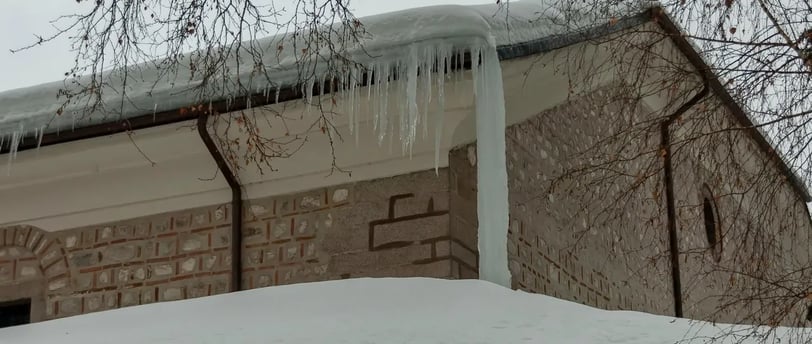How to prevent frozen pipes
8/7/20234 min read


Insulate Pipes
Check exposed pipes for insulation. If you're not sure whether your pipes are insulated, take a look at them. If they're exposed to the elements and there's no insulation on them, it's time to get some!
Use heat tape on exposed pipes that are less than 2 inches in diameter. Heat tape is available at hardware stores and home centers; follow the instructions on how much heat tape you'll need based on the length of pipe you have (the longer it is, the more wattage).
Insulate hot water heater tanks with foam insulation kits available at hardware stores and home centers before winter arrives so they don't freeze up during cold spells when temperatures drop below freezing outside--this can save homeowners hundreds of dollars per year in energy costs by preventing their water from freezing inside their tanks during cold snaps! Wrap cold water supply lines with foam sleeves before winter arrives as well--they won't prevent all freezing but they will help keep some moisture away from those lines so they don't freeze completely solid if temperatures plummet unexpectedly overnight while everyone's asleep at home sleeping soundly unaware that this could happen until morning comes around again...
Keep the Heat On
Set your thermostat to at least 55°F. The lower you can keep it, the better--but don't go below 50°F if you have elderly people living in your house or children who might get cold quickly.
Add extra insulation around your water heater. If there's an opportunity to add more insulation around your water heater (or other appliances), do so! This will help prevent heat loss those pipes
Open cabinet doors near where your pipes are located. Opening up cabinets near where they run can help warm up those spaces by allowing more heat from inside of them into the surrounding area.
Let Faucets Drip
Set your faucets at a slow drip
Or even leave them running slightly overnight
If you have an outdoor hose bib (the outdoor faucet where you attach hoses), turn it on so that it drips into the ground around the house.
Seal Air Leaks
If you have a leaky faucet, it's important to fix it as soon as possible. Check for drafts around windows and doors. Seal the gap with weatherstripping or foam insulation tape.
If you live in an older home, there may be gaps between your pipes and walls that allow cold air into your house during the winter months. These gaps can be sealed with caulk or foam insulation tape
Disconnect Outdoor Hoses
The most effective way to prevent frozen pipes is to keep a slow trickle be done by disconnecting hoses from outdoor faucets, draining and storing them for the winter. If you don't have room in your garage or shed, consider hanging them on hooks inside an unheated area such as an unfinished basement or garage door opening.
To prevent freezing when using an indoor faucet:
Run hot water into the sink until it starts to overflow (the overflow should be located near where the drainpipe enters the wall).
Turn off any other taps that might be running at the same time as this one so that no more cold water enters into your home's plumbing system.
Install a Heat Lamp
Install a heat lamp near exposed pipes. This helps to keep the pipes warm and prevents them from freezing, which can lead to burst pipes and water damage.
If you have an outdoor faucet, cover it with insulation during cold weather. You can also useulators or a drain extension if necessary.
Install an Automatic Shut-Off Valve
The best way to prevent frozen pipes is with an automatic shut-off valve. If you don't already have one, contact a professional plumber or contractor who can install one for you.
Keep Closed
Keep the garage door closed when temperatures drop.
If you have a crawlspace or unfinished basement, take extra precautions.
If you live in an area where the temperature drops below freezing, it's important to keep your garage door closed at all times. This will help prevent cold air from entering into your home through cracks around windows and doors and help keep heat inside your house longer than if there were no barrier between it and outside elements like wind chill factors or snowfall accumulation on top of roofs/shingles (which also causes ice dams).
Keep Pipes Warm
Open cabinet doors to allow heat to reach pipes. If you have a basement or crawl space, open the door and let in some warm air. The same goes for any closets that contain pipes, such as laundry rooms and bathrooms.
Use a space heater to keep pipes warm. If your home is heated with natural gas or propane, you can use a portable heater to keep the temperature above freezing at all times--just make sure it's not too close!
Use an electric heating pad on exposed pipes that are exposed (for example: those running through exterior walls). Be sure not to place them directly against insulation though; this could cause damage over time due to overheating of insulation materials like fiberglass batting or mineral wool batts which could lead them becoming brittle enough where they may break off into smaller pieces inside your walls/flooring systems causing clogs downline from where these broken off pieces end up settling inside after breaking away from larger chunks left behind after being dislodged due...
Know Where Your Shut-Off Valve Is
The first step to preventing frozen pipes is to know where you off. If you have a basement or crawlspace in your house, then it's likely that there are several valves located throughout those areas.
When winter comes around and temperatures drop below freezing, make sure all of the water lines are turned off so they don't burst from the pressure of expanding ice inside them.
